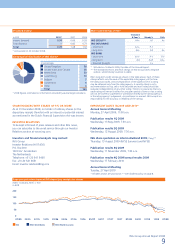ING Direct 2008 Annual Report Download - page 21
Download and view the complete annual report
Please find page 21 of the 2008 ING Direct annual report below. You can navigate through the pages in the report by either clicking on the pages listed below, or by using the keyword search tool below to find specific information within the annual report.
ING Group Annual Report 2008
19
For many years, as part of its capital management policy, RAROC
methodology and transfer pricing business model, ING Bank has
used a system of capital investment rules and of capital charging
and benefits to manage the balance sheet and make business
results comparable. Capital is invested credit risk free (notionally)
and the returns on the assets in the capital book are charged away
from the business units in return for the euro risk free rate on the
Economic Capital they employ. Business units with this method
become insensitive to the local capital they actually hold but
become sensitive to the Economic Capital they employ. Capital
can no longer be used as free funding to support earnings.
This management accounting method makes all business units
comparable as it includes the adjusted return over Economic
Capital, irrespective of the amount of capital they hold and
currency conditions they operate in. This then facilitates optimal
allocation of capital as the returns on Economic Capital reported
by the business units are comparable.
CAPITAL MARKET OPERATIONS
In 2008, the following issues were done:
For ING Groep N.V.
EUR 10,000 million core Tier-1 securities•
EUR 1,000 million 5-year senior unsecured bond•
EUR 1,500 million hybrid Tier-1 capital in retail market•
USD 2,000 million hybrid Tier-1 capital in retail market, fixed rate•
For ING Bank N.V.
EUR 1,000 million 5-year covered bond•
EUR 4,000 million 2-year senior unsecured bond•
EUR 2,000 million 10-year covered bond•
EUR 3,500 million 3-year senior unsecured bond•
EUR 1,000 million lower Tier-2•
GBP 800 million lower Tier-2•
USD 1,250 million extendible, institutional market•
LIQUIDITY FACILITIES
Although demand from international investors for securitised
assets has all but disappeared and securitisations of a bank’s own
assets have become less effective under Basel II, 2008 was a very
active year for securitisations. Under Basel I the sale of (super)
senior tranches of securitisations to investors led to a significant
reduction of RWAs on the bank balance sheet without a significant
transfer of risk taking place. This arbitrage is no longer possible
under Basel II. Also, after the summer of 2007 the market for
securitisations dried up, even for the most highly rated senior
tranches of securitisations. However, lack of liquidity in the
unsecured money markets has since then raised the demand for
eligible collateral and this has created a new use for securitisations.
The transaction can be summarised as follows: a bank sells a pool
of mortgages to a Special Purpose Vehicle (SPV). The SPV issues
secured notes in two tranches, one subordinated tranche and one
senior tranche, the latter rated AAA by the rating agencies. The
bank buys both tranches, but can now use the AAA-rated tranche
as collateral in the money market for secured borrowings. With
the securitisation, illiquid assets have thus become to a large extent
liquid. The Basel II RWAs of the bank remain unchanged. During
2008, ING Bank created a number of these securitisations through
which in total approximately EUR 70 billion of AAA-rated notes
were created. Own-originated mortgages in the Netherlands were
used as the underlying assets. Apart from the structuring and
administration costs these securitisations are P&L neutral.
ACQUISITIONS AND DIVESTMENTS
In 2008, the acquisitions and divestments of ING Group balanced
in terms of transaction value. Total divestments in the amount
of EUR 1.5 billion comprised mainly of the sale of the Mexican
non-core insurance business to AXA and the sale of our Taiwanese
life insurance business to Fubon Financial Holding (closed on
11 February 2009). Furthermore, we closed the sale of NRG
to a subsidiary of Berkshire Hathaway in June 2008 which was
announced in December 2007. In South Korea we sold our 20%
stake in the asset management joint-venture KBAM to KB Financial
Group while we acquired the remaining 14.9% in ING Life Korea
from Kookmin Bank. ING and KB Financial Group remain
committed to their strategic partnership in Korea via the 49%
stake in KB Life Insurance while ING increased its stake in KB
Financial Group to 5.05%. Add-on acquisitions amounted to a
value of about EUR 1.3 billion in 2008 and include the acquisition
of CitiStreet in the US, Interhyp in Germany and Oyak Emiklilik
in Turkey.
On 19 February 2009 we completed the sale of our stake in ING
Canada via a secondary offering for proceeds of CAD 2.2 billion
(EUR 1.35 billion).
























